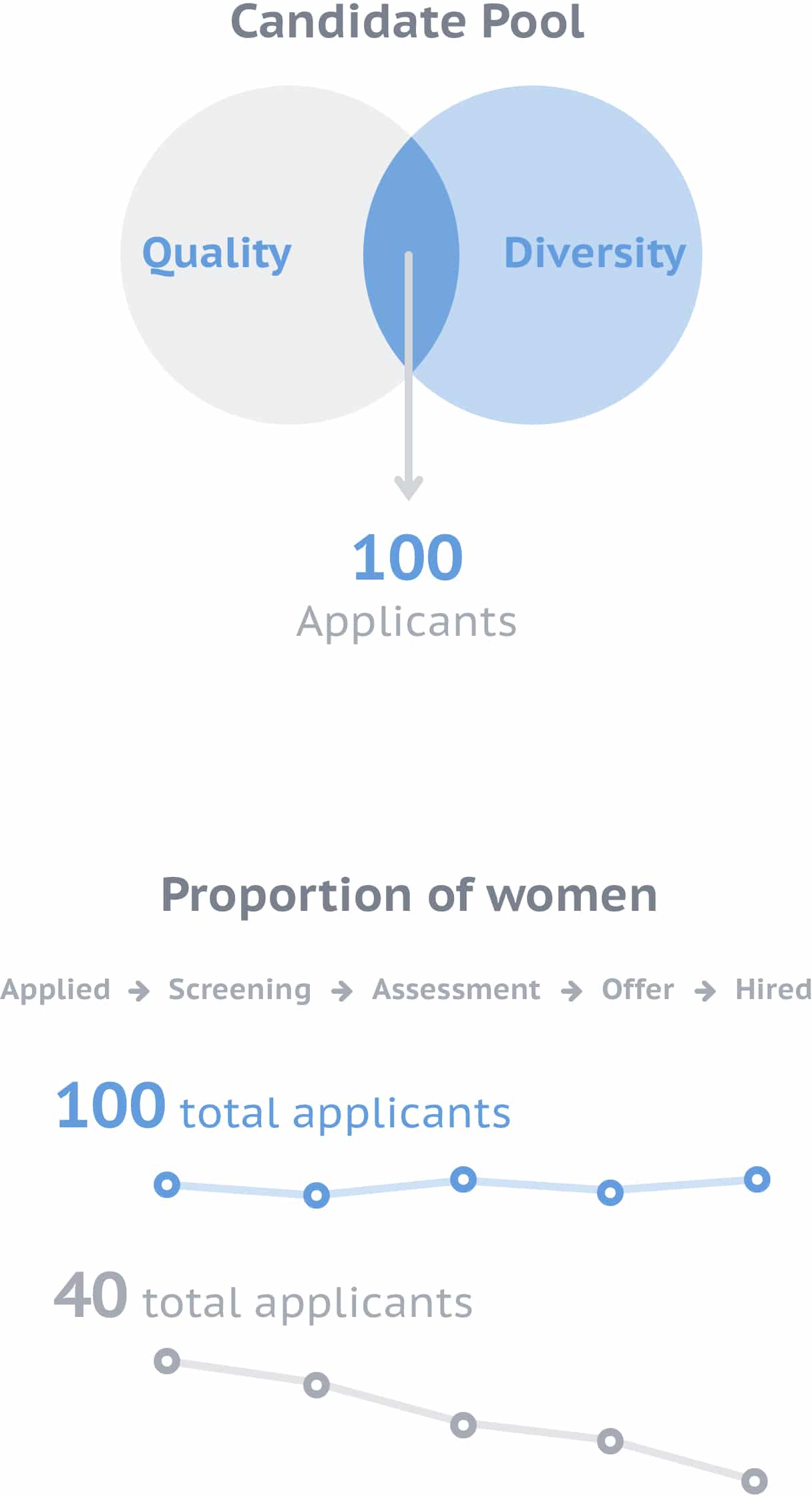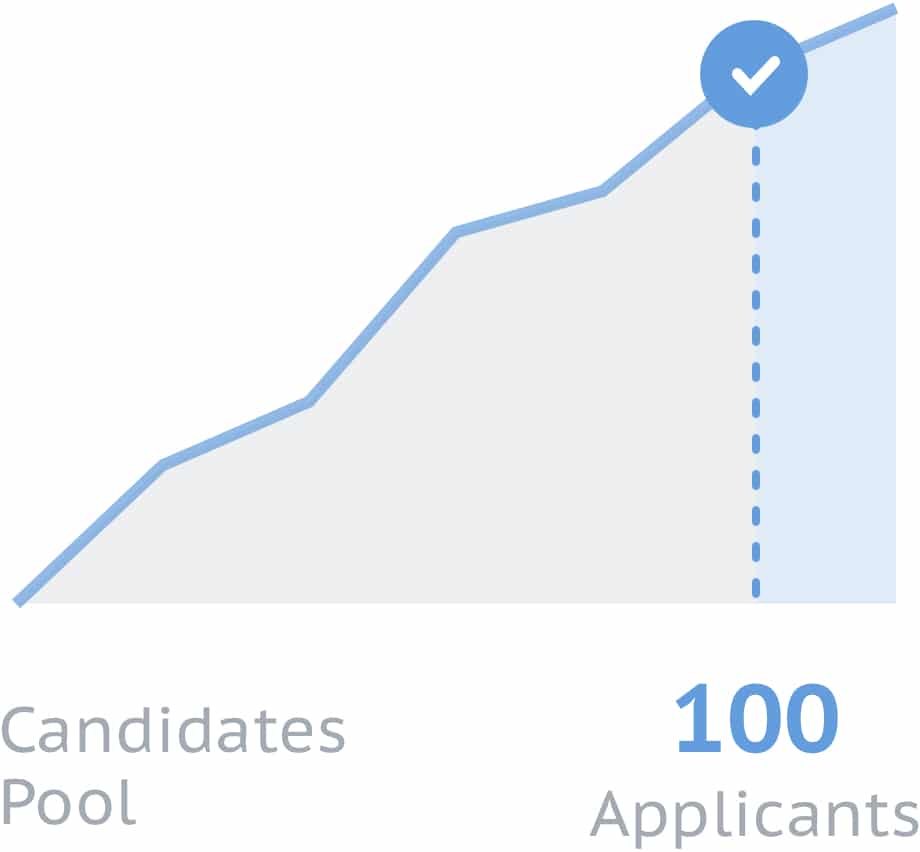The best way to create fairness at the end of the hiring process is to create fairness at the beginning with a representative candidate pool. Before any recruiting diversity hacks.
Put differently, attracting a qualified, representative candidate pool at the top of your funnel will naturally result in a more qualified, diverse candidate pool at the bottom. One way to ensure you get a representative candidate pool is to wait until you have at least 100 applicants before looking at resumes.
Diversity at the top creates a qualified, diverse candidate pool at the bottom
Recruiting diversity hacks don’t create diversity if diversity doesn’t already exist in your candidate pool. (It’s as if hiring teams are treating the symptoms of an illness without treating the underlying cause.) Meanwhile, our research has shown that large candidate pools naturally yield a diverse pool of qualified finalists. (Here’s our lead research scientist, Maryam Jahanshahi, talking about our research.)

When we looked at how the total number of applicants in a candidate pool impacts overall quality and diversity, we found a sweet spot of around 100. That’s the number that yielded a qualified, diverse pool of finalists.
In one study, we had a group with a median of about 40 applicants for data scientist positions and another with a median of about 100 applicants. For the group with 40 applicants, we found that the number and proportion of women went down at every stage of the process. For the group with 100 applicants, the number and proportion of women, as well as other markers of diversity, remained fairly standard.
We found that if you have 100 total applicants, 40 of which are female, you have a 40% chance of hiring a female candidate at the end of the process. And this isn’t just for data scientists; we’ve seen this scenario play out similarly for different roles.
Many companies say they can’t get above 25% female applicants for common technical jobs like data scientist. But our research shows that there’s actually a pretty large pool of female job seekers for those positions if companies can tap into it without inadvertently turning them off.
Let your candidate pool mature
Lots of things can get in the way of reaching the goal of 100 applicants. If you’re struggling to attract candidates, resist checking your applicant tracking system (i.e., Greenhouse, Workday, et cetera) too frequently. In fact, commit to waiting a while before looking at resumes, if possible.
It could mean that your hiring team is cutting the application process short. That’s one knock against the Rooney Rule. Organizations that shut the process down once they get one ethnic-minority applicant aren’t reaching real-world diversity levels.
A large candidate pool will naturally yield a qualified, diverse set of candidates. We consider 100 applicants to be a good number for the top of your applicant funnel. Depending on the size and brand recognition of your company, however, that number may be lower.

Give your candidate pool some time to mature before you start looking through resumes. That way, you’re comparing candidates fairly and not just hunting for the best in the first handful of applicants. (If you never get to 100 applicants for any position, use your judgment on what a mature candidate pool means for your company.)
Take a look at your job description
If you’re still not reaching 100 applicants after waiting, you could have issues with your job description. Job descriptions are a lot more technical than most hiring teams realize.
Maybe your job description isn’t coming up in searches on job boards because your job title is obscure (e.g., Brand Ninja). Job boards and candidates use titles as keywords for job searches, so it’s important to use industry-standard job titles. Also, an obscure title can confuse job seekers and deter them from applying.
Perhaps your job description is missing content that matters to job seekers. Diversity statements aren’t necessarily exciting, but they are reassuring. They tell job seekers that diversity matters to your company. Your job descriptions should include them.
Or maybe certain language in your job description gives off signals that your company doesn’t want to give. Sure, you’ll want any candidates for a Lead Engineer position to be self-motivated. But including soft skills like self-motivation eats up precious space on your job description without offering anything substantive for candidates to weigh. Leave them out.
Let your candidate pool reach 100, then look at resumes
Simply put, the best way to create fairness at the end of the recruiting process is to create it at the beginning, before any diversity hacks. By reaching a large enough candidate pool─around 100 applicants─you can carry fairness through every stage of the hiring process. It’s the best path to diversity.
How you get to 100 applicants in your candidate pool depends on many factors. Your hiring team has to wait long enough. Your job descriptions have to show up on job board searches. And the language you use in your job descriptions can’t inadvertently put off groups of job seekers. If you’re not reaching 100, take a step back and assess your processes and job descriptions.
